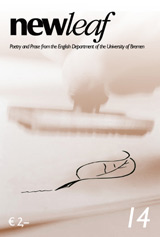editorial

Just a tad boring?
What's in a number? Fourteen - all sharp edges and very little substance. For while its forerunners were a football team, a dozen and then an unlucky baker in that order, and its successor will be one and a half decades, the number Fourteen is, well, just a tad boring. Not a primary number. Nothing symbolic. "Sweet little sixteen" maybe, or "Twelve good men and true". You won't even find Fourteen in the Penguin Book of Quotations, where there is one mention of 'Fifteen' [Harriette Wilson, 1789-1846; who? The Duke of Wellington's mistress, no less] and one for 'Thirteen' [W. J. Turner, Georgian poet, 1889-1946]. Twice seven doesn't double the magic number, it just softens it. Who'd be scared of the fourteenth son of the fourteenth son? Or Friday the Fourteenth? The only thing Fourteen was ever good for was the sonnet - and we don't even have one in the pipeline. Oh, and Juliet of Verona, of course; but then she's the wrong genre for a magazine.
What's in a number? A hundred and sixty is the maximum number of signs you can use when you write an SMS, a short text message, on your mobile phone. If it is true, as the moanies keep on telling us, that the email has put paid to spelling, text editing, courtesy and grammar, what effect, we wondered, would the SMS have on the face of English poetry? So the members of Bremen's Poetry Workshop were set the task of writing a poem in SMS style and we have printed a selection here.
What's in a number? One-O-One is the number of words in an exercise used in creative writing workshops. The assignment consists of a hundred-word text with a one-word title, and the task is to create a prose poem, a snapshot moment or a mini-story. It is an exercise in conciseness and a game with that tension between formal artistic strictures and the anarchic primal soup where the mind and the pen always want to wander. Julia Boll spent a semester at Liverpool JMU and got addicted to the One-O-One, bringing it back with her from the Mersey to the Weser. We reproduce some by her and one by newcomer and Liverpool supporter of a different kind, Tina Richardt.
We feel that including texts written as assignments in creative writing workshops is a quick burst of 'back to the roots' and hope that readers welcome this development. While we are proud that we have become international as we have grown towards the professional product that newleaf now is, we still do very much believe in the new.
Liverpool is the starting point for another project we are launching. In this issue we have published two travel essays on experiences students have had away from home - one by a Bremen author, one by an American visitor to Germany. Now we'd like to read what others have experienced in the tumult of coming to terms with the 'other' culture. Between "A Stormy Place" and "Ich bin Berliner" you will find the announcement of the next newleaf writing competition. Go to the shop and buy a newpad.
We have a further piece of autobiographical non-fiction. Werner Parusel wrote a boyhood memoir of the bombing of Dresden in 1945 on the occasion of the visit to Bremen by the Australian poet Katherine Gallagher, who has written about and against war over the years. It is a fitting counterpoint to his Bremen war memoir of April 1945 which we published in No. 9.
The back page of 14 is an ad for the British Studies magazine Hard Times from Berlin: check it out.
Finally, the two illustrations in this issue are by Delmenhorst poet and artist and newleaf staff member Rosi Oelke, the 'sewing woman' who also produced the banners which grace our bookstalls. The linocut at the back is based on an illumination from an old Irish book.
Simon Makhali and Ian Watson, November 2002
contents
-
Zulu Watercat (continued)
-
Franziska Kreuser
Julia Boll
Lenka Podhrazsky
Jana Mewis
Patricia Schultz
Antonia Bargery
-
The Dreadful Silence
-
Graduation
-
A Stormy Place
-
Competition Announcement
-
‘Ich bin Berliner’
-
Deadly Ambrosia
Ballooning Hysteria
-
Julia Boll
Tina Richardt
-
Memorials
Midnight
-
Upside Down
